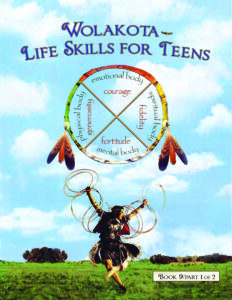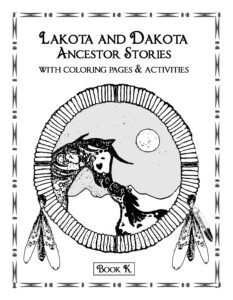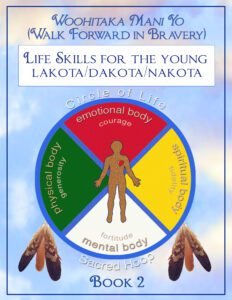Oceti Wakan: Mending the sacred fireplace
 PINE RIDGE – About a mile or so up Tobacco Road in Pine Ridge, sits a cabin that Cindy Catches shared with her husband, medicine man Peter Catches until his death in 2018. Cindy was raised in a coal mining community in the mountains of West Virginia and had a strong affinity to Native people who had lived in and around her mountains. Growing up she was aware of a Native American spirit who was communicating with and guiding her. One day, she was making a moss house in the woods and was told that she would marry someone special. She would find him when she had developed spiritually.
PINE RIDGE – About a mile or so up Tobacco Road in Pine Ridge, sits a cabin that Cindy Catches shared with her husband, medicine man Peter Catches until his death in 2018. Cindy was raised in a coal mining community in the mountains of West Virginia and had a strong affinity to Native people who had lived in and around her mountains. Growing up she was aware of a Native American spirit who was communicating with and guiding her. One day, she was making a moss house in the woods and was told that she would marry someone special. She would find him when she had developed spiritually.
Her first connection to the Pine Ridge Reservation came through her meeting her future father-in-law, legendary medicine man Pete Catches. They crossed paths at a conference in 1989 and Cindy understood that Pete was the medicine man she had seen in a dream. Coretta Scott King had asked Cindy to bring Indigenous Elders to meet with her and other leaders of the Black community in honor of her husband, Dr. Martin Luther King Jr. Pete Catches was invited back again the following year and his relationship with Cindy grew and solidified as a result.
Patricia Locke had served as a mentor to Cindy and was involved in introducing a bill that would protect Native American religions. Pete Catches had a stroke during this time period and his grandson asked Cindy to come to the Pine Ridge Reservation to take care of him. It was then that she met her future husband, medicine man Peter Catches. Both understood immediately that their destinies were entwined in spite of the fact that their cultures were so different. It took all of their courage to take a leap of faith and commit to each other in marriage.
Pete and Peter Catches, with Cindy’s assistance, began to develop the dream of Oceti Wakan, the sacred fireplace. It is the place where the highest and finest qualities of Lakota culture and spirituality come together. In 1989, Pete and Peter formed a 501c3 non-profit organization focused on preserving the Lakota language, culture and healing for the people. Pete Catches had the vision but it was Peter along with Cindy who brought it to fruition.
Pete Catches dictated his book, “Sacred Fireplace: Life and Teachings of a Lakota Medicine Man,” to Robert Holden so that Lakota people would learn about Lakota culture from a Lakota mind. This was Oceti Wakan’s first publication for the people.
The language was the next concern as the culture is kept through the language. Peter felt the language needed to be taught through sentences. There are many sentences where you cannot separate the individual words or they lose their meaning. Oceti Wakan received a $75,000 grant to canvas the nine districts to access the needs of the community. In doing so, they found that only 2% of the people in the 2 to 17 age group could speak the Lakota language but 45% had a first language speaker in their household. The two healthiest districts in terms of language on the Pine Ridge Reservation were found to be in Oglala and Wanblee. This information provided solid data to build upon. At that time, Cindy and Peter were living in a 300 square foot shack and traded beaded moccasins for a used computer. Their program was born with their language curriculum. They found that children did not speak the Lakota language because they did not want to be laughed at. A language course was organized in Porcupine in 2004. They found that many young parents in district meetings expressed a desire to learn the Lakota language along with their children.
 They created Lakota Language Learning Stations in order to learn the Lakota language, the children wore headsets to hear the spoken word then record themselves repeating back the same sentence. Cindy said she could see the light go on in the children’s eyes as they began to understand the meaning of the words. Lakota Elders were enlisted to teach the language in Porcupine. The program was what would later become a published school book which was produced for Lakota parents entitled, “Guiding Your Child in Speaking the Lakota Language.”
They created Lakota Language Learning Stations in order to learn the Lakota language, the children wore headsets to hear the spoken word then record themselves repeating back the same sentence. Cindy said she could see the light go on in the children’s eyes as they began to understand the meaning of the words. Lakota Elders were enlisted to teach the language in Porcupine. The program was what would later become a published school book which was produced for Lakota parents entitled, “Guiding Your Child in Speaking the Lakota Language.”
Peter Catches began to give lectures and perform ceremonies around the country. Cindy came to understand that true spirituality was the same regardless of whatever name it was given. What was presented in these lectures formed the basis for the curriculum that was developed in recent years. By 2009/2010 Peter was deeply concerned with the 500 suicide attempts by children 9 to 24 on Pine Ridge. He prayed that he could find the answer on how to help the children want to live. He was invited to the National Institute of Health (NIH) to be on a panel with the United States Surgeon General C. Everett Koop as the moderator. When it came to Peter, he said, “Our children are killing themselves and I’m looking for answers.” Surgeon General Koop told Peter that they had been in the health business for over 70 years and what they have found the best money spent is in prevention, the sooner the better, even before the mother gets pregnant. Cindy and Peter came home to develop a medicine wheel curriculum.
It included the following:
The Medicine Wheel from the Spotted Eagle view represents the four aspects of the human being.
WEST is represented by the colors blue and green and represents the physical body. Mother earth is blue and green and is characterized by generosity.
NORTH is represented by the color red and defines what we need for our emotional body, our hearts. It is characterized by courage and encourages us to tell the truth.
EAST is represented by the colors yellow and gold. We find wisdom in the EAST where the Sun rises each day. It is characterized by enlightenment. A child does not yet have the tools to understand wisdom so they learn the characteristic of fidelity. Fidelity represents our relationship with our Creator, followed by the strength of our families. Combining these two things represents the strength of the Nation.
SOUTH is represented by the colors white and gray and is characterized by the sacred Spotted Eagle. It is characterized by fortitude which is needed in developing the mind.
 In the combination of the four directions, children have the ability to create a vehicle that can be guided by spirit. This curriculum starts in second grade where the students learn to express their feelings in a safe way. When they see addiction and other destructive patterns at home, they are able to choose a different path forward for themselves.
In the combination of the four directions, children have the ability to create a vehicle that can be guided by spirit. This curriculum starts in second grade where the students learn to express their feelings in a safe way. When they see addiction and other destructive patterns at home, they are able to choose a different path forward for themselves.
The Oceti Wakan pilot program began at the Wolf Creek School with an after school program for 4th and 5th grade students. Students were paired with a Lakota teacher and a white teacher to work on language skills. Their emotional body lessons focused on grief and fear by sharing an animal story about that lesson. Children need their ancestor stories for guidance. Marnie White Wolf developed a teachers’ book matching ancestor stories with each lesson. This provided the necessary preparation for teachers for each lesson.
Health and wellness practices such as keeping a journal, tapping, meditation, talking circles and later dance were incorporated into the curriculum as well as a handbook for parents. Children do better when their parents are involved, so they created a handbook to support what the children were learning.
This curriculum was introduced into the Oglala Lakota school program. The superintendent of schools saw it as a necessary tool to bring Oglala Lakota standards of culture and language to the students. It includes a life skills program to help the students make healthy choices, build good relationships and prepare to step into their role in the community along with supporting the healing of addiction in their own family. This is the foundational belief in the Lakota system, to strive for balance and peace and understand that we are all related.
Oceti Wakan and their curriculum is now in 40 schools on six of the seven Lakota reservations. Their goal is to have their program accepted into the public school system in Rapid City for the Lakota children living there. We must learn to get out of the way so that Lakota youth can connect to their ancestors and hear the beat of the Black Hills today.
Oceti Wakan will be hosting a Teacher’s Conference at Ramkola September 27th through 29th to support this wellness prevention curriculum from K-12.
For more information on Oceti Wakan please visit www.ocetiwakan.org
For additional information, please contact Mia Feroleto at mia.feroleto@gmail.com.
The post Oceti Wakan: Mending the sacred fireplace first appeared on Native Sun News Today.
